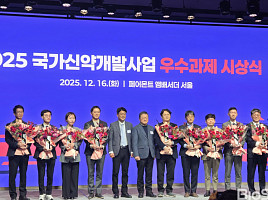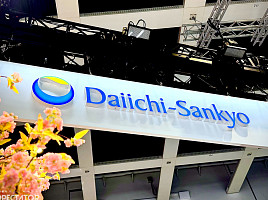기사본문
Standigm has 'evidence-based' AI-aided drug target discovery platform.."global competitiveness"
입력 2022-06-13 09:02 수정 2022-06-13 09:02
by Soyoung Yoon
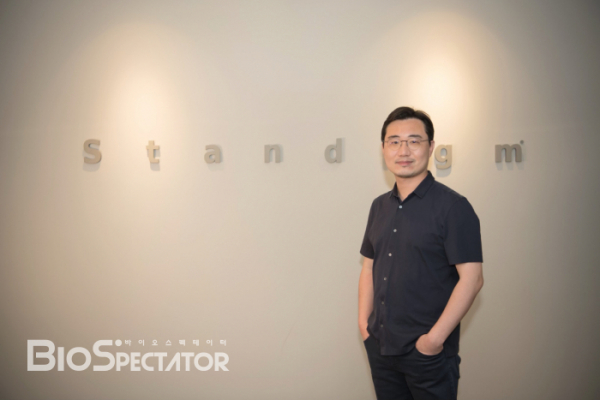
▲Jinhan Kim, CEO of Standigm
To discover new targets to cope with diseases, existing and new information are needed to predict the association between diseases and targets. However, the discovery of an relationship between target and disease through reading all published papers would be impossible. In addition, there is also a limit to keeping up with new information pouring in. This is the reason why it is difficult to discover targets despite lots of effort and time. We can see the difficulty from the fact that targets of therapeutic agents approved to date account for approximately only 3% of human proteins.
Standigm, an AI driven new-drug discovery company, had an eye on the exploitation of natural language processing(NLP) technology to cover a broad range of published papers. By applying AI, which is specialized in exploring hypotheses and prediction of consequences based on accumulated data, the company has developed a target discovery platform capable of presenting a new target and a compound discovery platform having an optimal design for the target. It is said that the period from target discovery to securing candidates, which took an average of 4 to 5 years, can be achieved in 7 months using Standigm's platform.
In particular, Standigm's target discovery platform differs from the existing AI platform in that it does not end with showing the target for the disease, but also provides the evidence that the target was derived. This implies that it is possible to even interpret how the target affects the disease. Insilico medicine, an AI drug development company that is leading the global market by entering clinical trials last year with drugs discovered with the target discovery AI platform, shows a target with effective value for disease. However, Jin-han Kim the CEO of Standigm emphasized, “The Standigm’s platform is presenting a new target for disease along with interpretable evidence”
The differentiation of the Standigm’s platform led to meaningful investment. Standigm attracted an investment of 10 million USD(approx. 11.2 billion KRW) from Pavilion Capital, a subsidiary of Temasek, last year. Pavilion Capital is a company invested in Insilico Medicine and Schrodinger, the most advanced companies in global AI drug development. CEO Kim said, “Standigm is the third company attracted investment from Pavilion Capital among those with an AI Drug Discovery Track. The investment of Pavilion Capital comes from a judgment that regards the technology and growth potential of Standigm as those of the other two companies”
Standigm received an investment of 80.3 billion KRW to date including the investment of Pavilion Capital. It has been continuing partnerships with domestic companies such as SK and Hanmi Pharm etc. Last year, Standigm opened offices in the UK and the US, and is preparing for global expansion.
CEO Kim also explained that Standigm's manpower is a strength. Of Standigm's 75 employees, 65(86%) are experts in AI, platform engineering, chemistry, life science, and medical science. AI and platform engineers make up half of them, and the other half are experts in chemical/life science fields. CEO Kim confidently said, "We have a balanced workforce composition, and there is no such workforce composition globally"
‘Standigm ASK’, a Novel Target Discovery Platform
CEO Kim said, “the capability of securing pipeline spontaneously through the novel target discovery platform is important. Otherwise, the AI based drug discovery company will have no choice but to service certain functions of other companies” He emphasized that Standigm is able to develop spontaneous ‘First-in-class’ pipeline via the novel target discovery platform.
The target discovery platform, the ‘Standigm ASK’, is a platform that can learn and analyze pathways of diseases and provide novel targets together with interpretable evidence. The key of the ASK platform is its capability of presenting relationships of disease, target, and compound with a graphical method through learning information of knowledge level data such as published papers and public information, sequencing data. Here, knowledge information refers to information at a level that goes beyond fragmentary data and has meaning by connecting data.
The ASK platform extracts information from data and expresses elements such as diseases, targets, and compounds as ‘nodes’ and the relationship between them as ‘edges’ in the form of lines. The ‘edge’ consists of 25 types capable of expressing the relationship between ‘nodes’, such as the ‘cause’, ‘association’, ‘down-regulation’, ‘up-regulation’, and ‘bind’, by which these ‘nodes’ and ‘edge’ constitute a graph form of knowledge information.
The AI of ASK platform learns information from the edges and nodes and finds common patterns. Patterns associated with disease and other patterns irrelevant are distinguished by the AI to provide a target with higher potential of therapeutic agent for a specified disease with appraised corresponding scores. Filters such as the level of known knowledge, whether the gene of interest is included, specific expression level, and competition situation, etc. can be applied to determine a more optimized target.
For example, if a query called ‘leukemia’ is entered into the ASK platform, targets related to leukemia are ranked according to priority. Among these ranked targets, if you select a target that suits your purpose and click on the graph, you will see how the disease is connected to the target. If a target called KDM6A is selected among the targets found after searching for leukemia, a graph with temozolomide as a treatment for leukemia appears, and a graph is drawn showing that it is also used as a treatment for glioblastoma and brain tumor. Here, the graph illustrates associations of KDM6A with leukemia and two other diseases. By expanding nodes, the graph illustrating more varied associations appears.

▲Example of using Standigm ASK platform(Standigm website)
CEO Kim said “the analytic capability of Standigm ASK that presents the route of target analysis for disease is the differential point” That is, a clearer biological pathway is presented through the analytic capability of ASK platform, showing the route of target and disease. The platform also identifies relationships of expression levels of a variety of genes, thereby enabling ‘in silico’ test within the platform.
The database used in this ASK platform can be added or changed according to the user, so it can provide more optimized results for specific diseases or conditions.
Currently, Standigm proceeds 20~30 novel target programs in four diseases. Although it is difficult to disclose in terms of contract, it has partnered with a global big pharma based in europe to conduct joint research, and is conducting joint research and validation of fibrosis disease targets with the Fibrosis Center at Ewha Womans University. Besides, co-researches with Milner Therapeutics Institute University of Cambridge for viral diseases, with SK Chemical for target discovery for NASH(Non-alcoholic Steatohepatitis), with SK C&C for NLP technology, and so on are in progress.
The Optimal Compound Discovery Platform, 'Standigm BEST'
Finding new targets is important, but when the ability to design compounds for new targets comes together, synergies arise in the development of in-house pipeline. Standigm developed the platform, the ‘Standigm BEST’, capable of designing optimal compounds for targets. Best platforms are based on public databases(such as PubChem, ChEMBL, ZINC, etc.) and commercial databases(such as GoSTAR, CDDI, etc). The platform applies a variety of algorithms to these databases to attain the ‘hit’, ‘lead’, and ‘lead optimization’ aiming at target compounds.
CEO Kim expressed, “the process to secure hit is a process of creating a material of new structure by plotting a point, the seed material, in a 150-dimensional space and migrating the point toward neighboring location of more desirable properties.” The process of becoming a hit is to apply a module that predicts binding strength to select a structure that is expected to binding better to the target.
The process of lead is a process of creating novel structure of molecule. For this, the scaffold database, the basic structure that defines properties of molecule, is exploited. When a rare scaffold is selected and introduced into the structure of the hit molecule, a reasonable structure can be created while maintaining the basic shape of the hit molecule. Lead optimization is a process of adding physical properties such as selectivity and structural stability to a material derived from the secured lead material.
Standigm proceeds the development of a total of 12 pipelines for five diseases via the BEST platform. The 12 pipelines are divided into in-house pipelines and partnership pipelines, and the most advanced among the in-house pipelines is 'SP001', a candidate for Parkinson's disease, whose preclinical candidate will be selected in the first quarter of this year.
SP001 is an LRRK2(leucine-rich repeat kinase 2) inhibitor. LRRK2 gene mutation is a major cause of genetic Parkinson’s disease, but there are some clinical trials targeting LRRK2 at its initial stages. Standigm discovered 11 lead optimized small molecules by exploiting the BEST platform, and 9 of them have been synthesized. 7 of these molecules were confirmed to have inhibitory effects on LRRK2 kinase at a level of 38 nM to 6.8 μM.(doi:10.1021/scimeetings.0c04601).
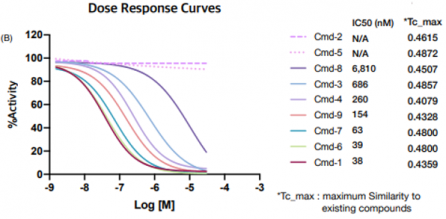
▲LRRK2 inhibitor candidate IC50 derived from the Standigm BEST platform (provided by Standigm)
Standigm in the Global Market
Standigm is an AI-based drug development company established in 2015. At this time, there were only about 10 AI drug development companies in the global market. AI drug development companies established around the same time include Insilico medicine(2014), Benevolent AI(2013), and Exscientia(2012), and so on.
CEO Kim said, “The process of new drug development can be broadly divided into four processes: drug discovery, preclinical, clinical, and commercialization. In preclinical and clinical trials, physical experiments on animals or humans are important. However, the exploration of hypotheses and prediction of results are keys for drug discovery” he added, “Artificial intelligence is better at processing structured and unstructured data than humans, searches for hypotheses quickly, shows high accuracy in predicting results, and provides values for a wide search range” CEO Kim established an AI new drug development company after seeing the potential of drug discovery as a field where AI can generate the maximum return on investment (ROI) in the process of developing new drugs.
Kim's prediction was correct. Currently, more than 300 AI drug development companies have been established in the global market, and global Big Pharma is showing interest in it. Only in this year, Astrazeneca extended its AI-based new target discovery partnership with Benevolent AI for three years, and Sanofi signed a $5.2 billion AI small molecule discovery partnership with Excentia.
Although many AI drug development companies have been established globally, their development directions can be broadly classified into three categories. One is the development of a target discovery platform capable of developing first-in-class new drugs, and the other is the development of a compound discovery platform that focuses on the development of best-in-class new drugs. In Standigm, Standigm ASK and Standigm BEST correspond to this, respectively. The other is a drug repositioning platform that finds new indications with existing drugs. Standigm also developed ‘Standigm INSIGHT’, a drug repositioning platform.
Although each company has different goals, many AI-based new drug development companies are aiming to develop a target discovery platform, and these companies are attracting attention, such as receiving a lot of investment and partnership with Big Pharma. In most cases, target discovery platform development companies also develop compound discovery platforms that can be used together with the target discovery platform.
Insilico medicine, Exscientia, and Benevolent AI are representative global AI companies of this case. Schrödinger and Atomwise are also global leading AI drug development companies, but they are different in that they focus on the discovery of optimal compounds.
How is the development status of global companies developing target discovery AI platforms?
Insilico medicine was spotlighted as the company proceeded clinical trials with its drug attained from AI driven target discovery platform. Insilico medicine is currently proceeding clinical trials (since November last year) for a novel target drug for idiopathic pulmonary fibrosis (IPF) discovered by AI. Insilico medicine has completed processes of target discovery, discovery of candidate molecule and preclinical study in ‘18 months’ with ‘2.6 million USD’ (approx. 3.1 billion KRW).
Whereas Insilico medicine was the first company to enter clinical trials with a drug discovered from a target discovery platform, the Excentia was the first company to introduce a drug designed by a compound discovery platform into clinical trials. Exscientia entered the drug of obsessive-compulsive disorder, developed by a collaboration with Sumitomo Dainippon Pharma, into clinical trial in 2020. It was the first case entered a clinical trial with the drug designed by AI. Subsequently, Exscientia entered compounds designed by AI into clinical trials twice last year. Benevolent AI is also proceeding a clinical trial for atopic dermatitis with the drug designed by the AI driven compound discovery platform.
Several companies have entered clinical trials for small molecules derived from AI driven drug-recreating platforms. A noticeable company among them is Recursion, an AI driven new drug development company that is developing 4 repositioning drugs in clinical stages. Recursion develops AI driven new drug platforms by exploiting data of cell’s image. The company also develops target discovery and compound discovery platforms. Last December, the company concluded a long-term contract of 10 years for the development of target discovery platform with Roche.
As presented so far, global leaders of AI driven new drug development companies are developing new drugs that enter clinical trials. There are no candidates for Standardigm that have entered the clinical stage yet. However, CEO Kim said, “there are about 5 companies in the world equipped with a platform capable of predicting and discovering novel targets” and “We can still be seen as belonging to a leading group in the global market, and we are closely following the leading companies.”
The most advanced asset in Standigm is the small molecule candidate(DR001) for non-alcoholic steatohepatitis (NASH). It comes from the Standigm INSIGHT platform, the drug repurposing platform. Currently, the molecule is in the stage of preclinical study. The next one is the small molecule candidate(DR004) for mitochondrial diseases. It also comes from the INSIGHT platform. It is in the stage of in vivo validation. In the first quarter this year, the candidate molecule for preclinical study for the Parkinson’s diseases, discovered from the Standigm BEST platform, will be selected.
Standigm also tries to secure an in-house novel target new drug development pipeline via the ‘Workflow AI’ that integrates platforms of Standigm ASK and Standigm BEST. According to CEO Kim, using Workflow AI, it is possible to discover new drug candidates from target discovery in just 7 months. Currently, about 10 anticancer drug candidates are being developed, and the six pipelines in the fastest stage currently have hit molecules. With this platform, Standigm is developing a total of 42 pipelines according to the strategy of ‘creating continuous value by increasing the probability of success by running multiple pipelines with high potential’. CEO Kim said, “The technology that can support this strategy is also AI technology.”
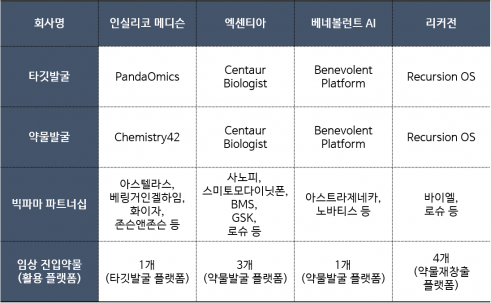
▲Status of major global AI drug development companies(by Biospectator)



